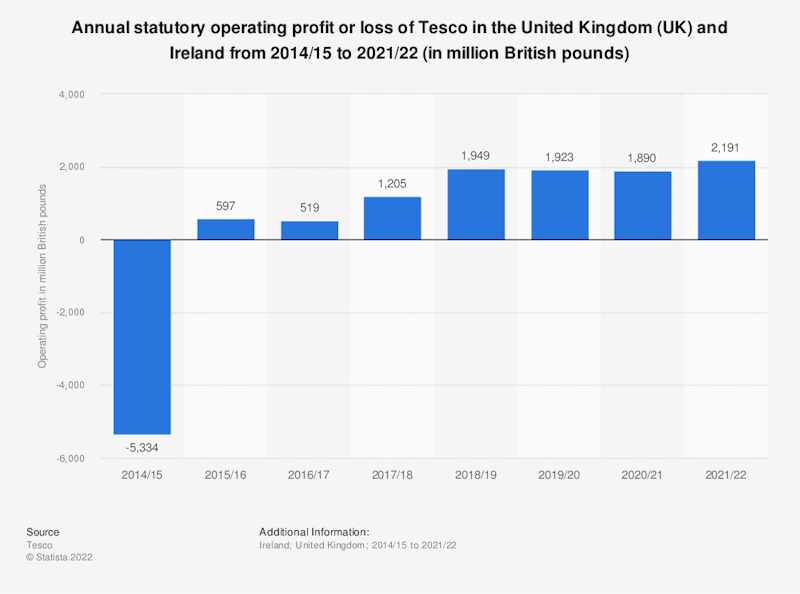Study Notes
Why is Tesco so profitable?
- Level:
- AS, A-Level, IB
- Board:
- AQA, Edexcel, OCR, IB, Eduqas, WJEC
Last updated 19 Mar 2023
This study note considers some of the reasons why Tesco remains one of the most profitable food retailers in the UK and maintains their position as the food retailer with the highest market share in the UK. Tesco's operating profit in the UK & Ireland was approximately £2.2 billion in the 2021/22 financial year.

There are several reasons why Tesco has been able to achieve high profitability.
- Economies of scale: Tesco operates a large number of stores worldwide, and this allows it to take advantage of economies of scale. This means that it can purchase goods and services at a lower cost because it is buying in bulk, and it can also spread its overhead costs across a large number of stores. Economies of scale lead to a fall in long run average cost (LRAC)
- Diversified revenue streams: Tesco has diversified revenue streams, including supermarkets, online grocery delivery, clothing and household goods, insurance, and more which allows them to spread risk and increase profitability. This is also another example of economies of scale.
- Data-driven decision-making: Tesco has a strong data analytics team, which helps it to better understand its customers and make data-driven decisions about its products and services. This enables it to optimise its pricing, inventory, and marketing strategies to increase profitability. The role played by their highly successful Clubcard loyalty scheme is vital in this respect.
- Supply chain management: Tesco has an efficient and well-managed supply chain, which helps to minimize costs and increase efficiency. This allows the company to keep prices low and pass those savings on to customers, which helps to attract and retain customers.
- Cost-cutting strategies: Tesco has implemented several cost-cutting strategies over the years, such as reducing its energy consumption and automating logistics processes, which have helped to increase its profitability.

Economies of Scale at Tesco
- Buying in bulk: As one of the largest retailers in the world, Tesco can purchase goods and services in large quantities, which allows it to negotiate lower prices from suppliers. This is known as bulk buying, and it is one of the most common ways that companies take advantage of economies of scale. This is known as an economy of scale from having monopsony power.
- Distribution and logistics: Tesco operates a large number of stores and warehouses, which allows it to spread the costs of distribution and logistics across a large number of locations. This includes things like transportation, warehousing, and inventory management.
- Advertising and marketing: Tesco can spread the fixed costs of advertising and marketing across a large number of stores and products, which allows it to achieve a higher return on investment.
- IT and technology: Tesco can take advantage of economies of scale in IT and technology by using standardized systems and processes across all of its stores. This allows the company to keep unit costs low and increase productive efficiency.
- Shared services: Tesco can share certain services across multiple locations, such as HR, finance, and legal, which allows it to achieve cost savings and increased efficiency. This is an economy of scope.
These are some examples of internal economies of scale that Tesco might use to increase its profitability. By utilizing these economies of scale, Tesco is able to reduce costs and increase efficiency, which allows it to keep prices low and pass those savings on to customers.
The Tesco Clubcard Loyalty Scheme
The Tesco Clubcard is a loyalty card program offered by the Tesco supermarket chain. Customers can sign up for a Clubcard and earn points for every purchase they make at Tesco stores. These points can then be redeemed for discounts on future purchases, vouchers for other retailers, or other rewards.
The Clubcard program is designed to encourage customers to shop at Tesco by rewarding them for their loyalty. Customers can earn points faster by purchasing certain products or by shopping at specific times, and they can also earn bonus points by using their Clubcard when they shop online or at Tesco's non-food stores.
The Clubcard program also allows Tesco to gather data on customer purchasing habits, which the company can use to tailor its products and services to better meet customer needs. Additionally, it enables Tesco to implement targeted marketing campaigns to specific customer segments based on their shopping behaviour.
You might also like

Premier Foods - Are they exploiting their monopsony power?
5th December 2014
External Economies of Scale
Topic Videos
Is Technology more about Profits than People?
20th September 2016
Market Structures in the Long Run
Topic Videos

What market structure best fits the music streaming market?
25th March 2018
Biggest offshore wind farm to start UK supply
12th February 2019

Monopoly - Eli Lilly cuts prices of insulin by up to 70%
1st March 2023

SuperDry may quit the London Stock Exchange in rescue plan
16th April 2024
Daily Email Updates
Subscribe to our daily digest and get the day’s content delivered fresh to your inbox every morning at 7am.
Signup for emails